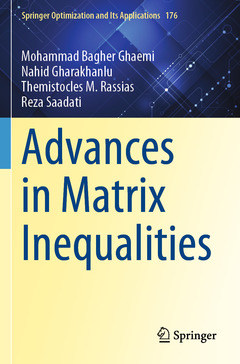Description
Advances in Matrix Inequalities, 1st ed. 2021
Springer Optimization and Its Applications Series, Vol. 176
Authors: Ghaemi Mohammad Bagher, Gharakhanlu Nahid, Rassias Themistocles M., Saadati Reza
Language: English
Subject for Advances in Matrix Inequalities:
126.59 €
In Print (Delivery period: 15 days).
Add to cartPublication date: 07-2022
277 p. · 15.5x23.5 cm · Paperback
126.59 €
In Print (Delivery period: 15 days).
Add to cartPublication date: 07-2021
277 p. · 15.5x23.5 cm · Hardback
Description
/li>Contents
/li>Biography
/li>Comment
/li>
This self-contained monograph unifies theorems, applications and problem solving techniques of matrix inequalities. In addition to the frequent use of methods from Functional Analysis, Operator Theory, Global Analysis, Linear Algebra, Approximations Theory, Difference and Functional Equations and more, the reader will also appreciate techniques of classical analysis and algebraic arguments, as well as combinatorial methods. Subjects such as operator Young inequalities, operator inequalities for positive linear maps, operator inequalities involving operator monotone functions, norm inequalities, inequalities for sector matrices are investigated thoroughly throughout this book which provides an account of a broad collection of classic and recent developments. Detailed proofs for all the main theorems and relevant technical lemmas are presented, therefore interested graduate and advanced undergraduate students will find the book particularly accessible. In addition to several areas of theoretical mathematics, Matrix Analysis is applicable to a broad spectrum of disciplines including operations research, mathematical physics, statistics, economics, and engineering disciplines. It is hoped that graduate students as well as researchers in mathematics, engineering, physics, economics and other interdisciplinary areas will find the combination of current and classical results and operator inequalities presented within this monograph particularly useful.
1. Elementary linear algebra review.- 2. Interpolating the arithmetic-geometric mean inequality and its operator version.- 3. Operator inequalities for positive linear maps.- 4. Operator inequalities involving operator monotone functions.- 5. Inequalities for sector matrices.- 6. Positive partial transpose matrix inequalities.- References.- Index.
Detailed proofs for all the main theorems and relevant technical lemmas are presented
Accessible to researchers, graduate students, engineers, physicists, economists
Unifies theorems and applications



